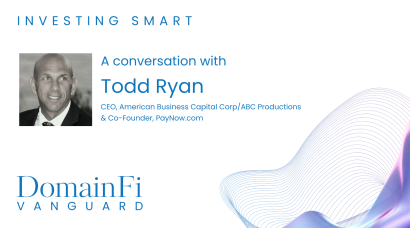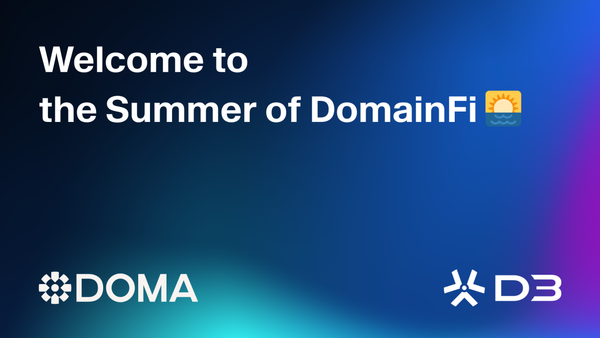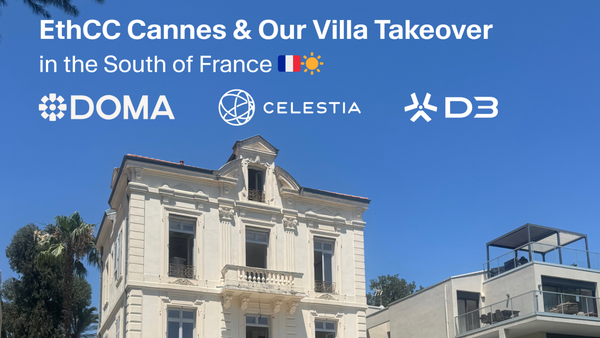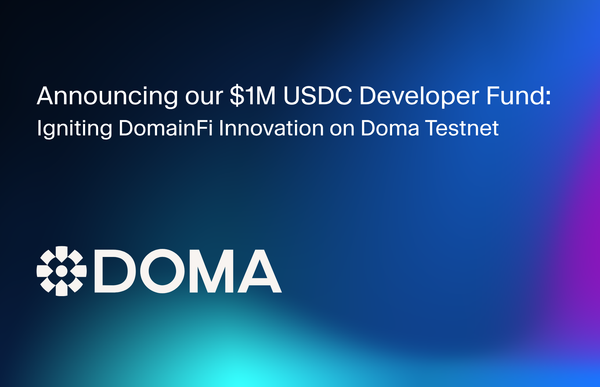Investing Smart: A Conversation with Todd Ryan (CEO, American Business Capital Corp/ABC Productions & Co-Founder, PayNow.com)

By Fred Hsu (CEO & Co-Founder, D3)
Todd Ryan is one of those rare domain investors who treats this business like a long game of strategy and margin. As CEO of American Business Capital Corp/ABC Productions and co-founder of PayNow.com, Todd’s career spans far beyond domaining, but it’s here, in the trenches, where he’s earned serious respect.
As one of the newest members of the DomainFi Vanguard program, I caught up with Todd to talk about pricing, liquidity, and why domain investing isn’t the side hustle most people think it is.
Fred: Todd, let’s just dive in. You’ve reduced your portfolio size from 5500 domains to approximately 1500 over the last 24 months. What’s the logic?
Todd: Great question, Fred. I’ve scaled my portfolio down from about 5,500 domains to 1,500 over the past two years because I’ve become more selective. I’m still bullish on a small segment of domains, but I’m bearish on most domain investing strategies, including some of my own from the past. So, I cleaned out what I considered the lower-quality names and have been focusing on domains with stronger upside potential.
Fred: You’ve talked about value investing. Share some specifics.
Todd: For value, I like meaningful one-word domains in non-.com extensions that pair well with the right-side of the dot, and .coms that are short, like LLLs, CCCs, and 4Ls. Also, when I see underpriced strong two-word .coms and certain brandables, I’m a buyer.
Fred: Where are you investing today and what’s your short-term outlook for the domain aftermarket?
For the past year, most of my investing has shifted toward building my startup, PayNow.com, but I still believe the next 2–3 years will be very strong for super-premium .coms. They tend to rise first and fall last, so I always tell domain investors to keep your eye on the top of the market, it often signals where everything else is headed.
Fred: You’ve said auctions are mostly noise now. Where do you hunt?
Todd: Primarily, I search for underpriced BIN listings on DNX.com but I still scan NameJet and DropCatch every so often. And, occasionally, I’ll look for low-priced 4Ls on NamePros.
Fred: You’ve said that repricing is critical. Can you unpack that?
Todd: Sure. In my early days, I had more of a "set it and forget it" mindset. I’d price a domain once and sometimes wouldn’t revisit it for years. But, as you know, the market is always moving, and static pricing doesn’t reflect that or make good sense.
For the past five years, I’ve made it a habit to regularly review and reprice my domains. I look at recent comps, market trends, and buyer behavior to make sure my pricing stays competitive and realistic. Repricing is critical, not just to avoid overpricing and scaring off potential buyers, but also to make sure you're not undervaluing names that have appreciated. Pricing is leverage.
Fred: You’ve been in domains long enough to see every cycle. What frustrates you most today?
Todd: I wouldn’t say it frustrates me exactly, but there’s one thing I have mixed feelings about, and that’s all the new blood entering the domain space. On one hand, it’s great. More participants bring more energy, attention, and awareness to domain investing, which benefits the entire ecosystem.
But on the flip side, it’s becoming harder for newcomers to find solid, trustworthy guidance. There’s a flood of self-proclaimed “experts” and “premium domain brokers” out there, and many of them have very little real experience. For someone just starting out, it can be tough to tell who’s legit and who’s full of shit.
Fred: Where does DomainFi fit into this?
Todd: DomainFi is showing up at just the right moment. My business partner Chad Folkening has been pioneering domain tokenization for years, but broad adoption has been slow, not because the concept isn’t strong, but because the infrastructure and recognition just weren’t there yet.
Now, thanks to years of effort from Chad and others in the industry pushing to legitimize domains as a true asset class, that shift is finally happening. DomainFi is helping modernize a category that’s long overdue for it.
It just makes practical sense. If I can borrow against a $100K domain instead of selling it, I preserve upside and extend my runway. If I can lease it while waiting for the right buyer, I create passive yield. Tokenization, leasing, and collateralization open the door to a whole new class of investors and professionals entering the domain space.
Fred: What roadblocks, if any, do you see?
Todd: The biggest roadblock is trust.
Most people, even those in tech or finance, still don’t fully understand how domain tokenization works, and that lack of understanding creates hesitation. If you don’t understand something, you’re unlikely to trust it, especially when money’s involved.
On top of that, registrars and marketplaces don’t always integrate well, which adds even more friction. To move forward, we need to simplify the user experience and strip away the technical barriers. People should be able to use domain names as collateral or income-generating assets without needing to understand blockchain mechanics or jump through hoops. When it feels simple and safe, adoption will follow. DomainFi’s got the right idea. Now it’s about execution.
Fred: Let's talk TLDs. Are you buying alternative extensions? If so, which ones?
Todd: Yes, I’m definitely buying alternative extensions, but I’m selective. As I mentioned earlier, I like strong, open-vessel words like “King,” “Tiger,” or “Climb” in non-.com extensions when the price is right. It’s all about value. You have to understand how a given alt extension compares in retail value to its .com counterpart, that context tells you whether it’s a smart investment.
I’ve picked up a few solid single-word .ai domains and taken some calculated longshots like .bot, which I still think has potential. That said, I mostly follow real demand. Founders are using alt TLDs every day in the real world, and if you ignore actual usage, you’re missing much of the market.
Fred: How do you evaluate a non-.com?
Todd: The first thing I look at is whether the keyword actually fits the TLD. Do the left and right of the dot make sense together? If they sound natural and create a brandable phrase, that’s a good start.
Second, I always check what’s going on with the .com version. Is it in use? Is it listed for sale? Who owns it? The status of the .com tells me a lot about potential competition, brand confusion, and the upside potential.
If the .com is parked or clearly for sale, it might create room for the alt extension if the asking price is high. If the price is low, that’s a big negative for me.
Third, is the renewal sustainable? I think .ai at $70/year for great names is a reasonable renewal price but it’s too much if your strategy is investing in thousands of them.
Fred: What would you tell a new investor who only has $5,000 to start?
Todd: If you’re new to domain investing and you’ve got $5,000 to start, my advice is don’t spend it yet. Take at least six months to study the space. Look at NameBio to understand sales comps, browse different marketplaces, and get a feel for what actually sells.
Most importantly, educate yourself. I co-host the DNX Show podcast every Thursday with Josh Reason, who’s a sharp and experienced domain investor. We cover all aspects of the industry, and I’ve become a better investor myself just by learning from our weekly discussions.
I also recommend checking out the Domain Name Law Show, which I co-host every Tuesday with attorneys Jeffrey Neuman and David Michaels. We break down legal topics relevant to domain investors, from acquisition risks to UDRPs and how to protect yourself when buying, using, or selling domains.
Both podcasts are free and packed with practical insights for investors at all stage. We broadcast on X and you will see that I post show links on my X account @abcproductions, so follow me there. You can also find more information on each show at DNX.show and DNLshow.com.
So, my one sentence answer to your question is, invest in knowledge first, it’ll save you a lot more than $5,000 in the long run.
Fred: What’s the biggest myth in this business?
Todd: That domain investing is easy. It’s not. People think you just buy a few names and wait for the offers to roll in. The reality is that it’s capital-intensive, research-heavy, and can often be emotionally draining. This isn’t like trading stocks. You can go months, even years, without a single sale.
Over 90% of domain investors will never turn a profit. Patience isn’t just a virtue, it’s a survival skill. And even then, it’s not always rewarded. Domain investing can be incredibly rewarding, but it’s definitely not for everyone.
Fred: Five years from now, what does success look like for DomainFi?
Todd: Five years from now, success for DomainFi means domains are no longer just seen as web addresses, they’re recognized as true digital assets.
People will use domains as usernames, for messaging and calls, to receive crypto payments, all tied to on-chain ownership as the standard. Every transaction will be public, secure, and instant. You’ll be able to lease, collateralize, or fractionalize a domain in seconds, just like any other asset class.
And most importantly, a new wave of investors will treat domains as capital assets. That shift in mindset is the breakthrough we’re building toward.
Fred: Appreciate you, Todd. Thank you so much for doing this.
Todd: It was my pleasure. Thank you Fred.




